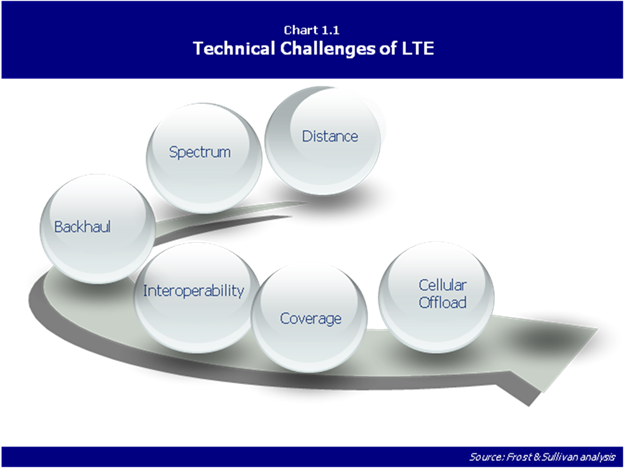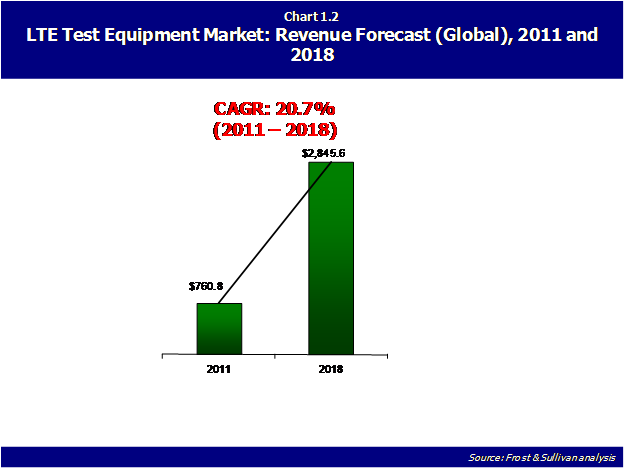Any new technology deployment presents challenges, and long-term evolution (LTE) is no exception. Moreover, as LTE is not an evolution of existing deployments, but rather a replacement that is backward-compatible, the challenges this technology brings with it seems more pronounced and includes the following: distance, spectrum, backhaul, interoperability, coverage and cellular offload.
Below is a brief description of these challenges.
Chart 1.1 represents the technical challenges associated with the adoption of LTE.

Distance – Robust LTE signals do not travel as far as signals that use existing radio techniques. As a result, the infrastructure designs include more towers, more base stations and more expense for land, permits, equipment, backhaul, monitoring, management and testing.
Spectrum – Spectrum tends to be in short supply with LTE, as it requires more radio spectrum. New or repurposed spectrum can take a decade or more before it becomes available; however, customers require mobile data services now and are prepared to switch to a different service provider, if their needs are not met.
Backhaul – Most cellular sites are still serviced by a T-1 for backhaul, which is insufficient for mobile data and LTE because of current and future capacity demands. Cable operators may have an advantage as many have high-bandwidth services available in areas where cell sites are or will be located. The movement toward Ethernet and IP mobile backhaul is expected to continue throughout the next few years.
Interoperability – Although LTE is intended to be compatible with most existing wireless transmission methods, cellular service providers (CSP) have been known to customize their networks. This can create problems with handoffs, roaming, packet loss, jitter/delay for voice traffic and a number of other assurance issues.
Coverage – LTE requires a large number of high-bandwidth mobile data users to justify the investments of service providers (SP) and network equipment manufacturers (NEM). It is therefore most likely that LTE will not be deployed in locations outside major metropolitan areas right away. As customers roam, they will experience numerous handoffs and service degradations. The exception may be the rollout of LTE for fixed-broadband substitution in areas where it is more practical to use wireless than wireline.
Cellular Offload – Carriers are constantly looking for ways to offload network traffic to Wi-Fi networks. However, new challenges arise from cellular offload, which extend beyond traditional Wi-Fi.
Test Equipment is the Answer
All of the LTE technical challenges listed above have a direct impact on the quality of service (QoS) and quality of end-user experience (QoE), crucial for SPs. Today’s consumers are used to doing things on the go. If a smartphone user continually experiences difficulties downloading e-mails or videos on his/her smart devices, a prompt switch of SPs will occur. This connection between positive user experience and customer churn has been clearly determined through various studies.
According to Frost & Sullivan’s latest research, the global LTE test equipment market generated revenue of $760.8 million in 2011. In 2018, revenue is expected to reach $2,845.6 million, at a CAGR of 20.7 percent. The market is driven by the increasing deployment of LTE and the explosion of wireless data. The growth of mobile data traffic is due partially to the availability of high-speed networks; the increased penetration of smartphones, as well as connected devices, such as laptops, netbooks, notebooks and tablets; and the use of higher bandwidth-consuming applications and services.
LTE is expected to create numerous opportunities for wireless test equipment vendors during the forecast period.
Chart 1.2 represents the revenue forecast for global LTE test equipment market from 2011 to 2018

Testing for Interoperability
LTE operates within the multi-vendor environment, thus SPs and NEMs must ensure that all the vendors implement the newest standards and that compliance is properly met. Test equipment solutions are important to ensure multivendor interoperability. The earlier interoperability testing is implemented during the deployment process, the better it is overall for SPs, NEMs and consumers.
Performance Testing
Mobile data traffic is on the rise primarily because of consumers’ desire to access internet and video on the go. Increased usage of smartphones, laptops, netbooks, notebooks and tablets – coupled with bandwidth-hungry applications and services – have contributed to the rapid growth of mobile data. According to Facebook, for example, more than 350 million active users currently access the social network through their mobile devices.
Additionally, more than 475 mobile operators work globally to deploy and promote Facebook mobile products. All factors listed above drive mobile data traffic growth; however, not all data traffic is generated by consumers. Actual data performance becomes extremely important and SPs need to ensure that they receive good throughput numbers in accordance to the technology in order to understand how it affects real world conditions.
Mobile Backhaul Testing
Due to the deployment of LTE, the whole backhaul is moving to new architectures, such as Internet protocol (IP) and Ethernet, creating growth opportunities for testing. New architectures are trying to provide the same level of quality required in time-domain multiplexing (TDM) networks.
In addition, smartphone applications, wireless data and video drive the need for increasing numbers of Ethernet 1G/10G test equipment to perform turn-up and maintenance on emerging LTE backhaul networks. High volume data usage puts tremendous strain on networks, thus, the demand for mobile backhaul testing is on the rise.
Wi-Fi Offload Testing
Historically, Wi-Fi access has been seen as "nice to have," and not put to significant use. Wi-Fi operators have therefore optimized their networks to provide coverage rather than capacity and QoS. In current offload networks, service providers use Wi-Fi as a continuation of their 3G/4G networks. Cellular offload requires Wi-Fi to deliver a positive customer experience, especially when there are a large number of users in high-density locations.
As a result, Wi-Fi networks have to become carrier-grade as it is a critical infrastructure element for the cellular network. Without this, it can lead to a negative user experience, which can result in the loss of revenue from high-profit margin smartphone consumers.
Consumers are constantly becoming more sophisticated and now have a choice of service providers that offer the best overall network for their smartphone needs. Today’s subscribers are no longer willing to accept poor Wi-Fi performance, as this leads to an unsatisfactory smartphone experience. Consumers expect the same quality of service on Wi-Fi networks as they have on 3G or 4G networks.
It is worth mentioning that one of the central themes of the Mobile World Congress in 2012 was Wi-Fi offload. Concurrently, cellular offload was the main focus for SPs and NEMs. Even though Wi-Fi has been around for many years, remarkable increases in mobile users' demands for data triggered by the popularity of smartphone adoption is driving a renewed interest in the idea of offloading cellular traffic onto Wi-Fi networks.There are a number of test equipment vendors that offer solutions to ensure that the mobile traffic is offloaded into Wi-Fi networks successfully. Ixia, through the acquisition of VeriWave, which offers wireless SPs an effective way of testing the performance of Wi-Fi offload. Ixia’s new IxVeriWave test system is designed to go beyond measuring network availability and signal strength to test a wider range of capabilities in order to demonstrate how a Wi-Fi network is delivering various applications such as voice, data, unicast or multicast video.
Spirent Communications is another key test equipment company. They introduced the addition of the Wi-Fi Offload Gateway testing capability to its Spirent Landslide solution. Landslide is capable of testing the performance of Wi-Fi Offload Gateways that handle offloading of data from sources such as over-the-top video (OTT), as well as traditional services such as voice calling and SMS, ranging from a 3G/4G/LTE cellular network to a Wi-Fi network.
Even though LTE is bringing in various technical challenges, there are numerous benefits associated with adoption of the technology. Communications test equipment vendors such as Anritsu, Rohde & Schwartz, Agilent, Aeroflex, Anite, Ascom, Spirent, Ixia, JDSU, EXFO and many others offer a number of effective testing solutions to address every challenge involved in LTE adoption.
Want to learn more about today’s powerful mobile ecosystem? Then be sure to attend the Mobility Tech Conference & Expo, collocated with ITEXPO West 2012 taking place Oct. 2-5 2012, in Austin, TX. Co-sponsored by TMC Partner Crossfire Media the Mobility Tech Conference & Expo provides unmatched networking opportunities and a robust conference program representing the mobile ecosystem. The conference not only brings together the best and brightest in the wireless industry, it actually spans the communications and technology industry. For more information on registering for the Mobility Tech Conference & Expo click here.
Stay in touch with everything happening at Mobility Tech Conference & Expo. Follow us on Twitter.
Edited by
Braden Becker  QUICK LINKS
QUICK LINKS